First Rutte cabinet
| First Rutte cabinet Rutte–Verhagen cabinet | |
|---|---|
|
68th cabinet of the Netherlands | |
  The cabinet members of the First Rutte cabinet on 14 October 2010 | |
| Date formed | 14 October 2010 |
| Date dissolved |
5 November 2012 (Demissionary from 23 April 2012) |
| People and organisations | |
| Monarch | Queen Beatrix |
| Prime Minister | Mark Rutte |
| Deputy Prime Minister | Maxime Verhagen |
| No. of ministers | 12 |
| Ministers removed (Death/resignation/dismissal) | 1 |
| Total no. of ministers | 13 |
| Member party |
People's Party for Party for Freedom (PVV) (Confidence and supply) |
| Status in legislature | Right-wing Minority government |
| Opposition party | Labour Party |
| Opposition leader |
Job Cohen (2010–2012) Jeroen Dijsselbloem (2012) Diederik Samsom (2012) |
| History | |
| Election(s) | 2010 election |
| Outgoing election | 2012 election |
| Legislature term(s) | 2010–2012 |
| Incoming formation | 2010 formation |
| Outgoing formation | 2012 formation |
| Predecessor | Fourth Balkenende cabinet |
| Successor | Second Rutte cabinet |
![Azure, billetty Or a lion with a coronet Or armed and langued Gules holding in his dexter paw a sword Argent hilted Or and in the sinister paw seven arrows Argent pointed and bound together Or. [The seven arrows stand for the seven provinces of the Union of Utrecht.] The shield is crowned with the (Dutch) royal crown and supported by two lions Or armed and langued gules. They stand on a scroll Azure with the text (Or) "Je Maintiendrai" (French for "I will maintain".)](../I/m/State_coat_of_arms_of_the_Netherlands.svg.png) |
|---|
| This article is part of a series on the politics and government of the Netherlands |
|
Local government |
|
The First Rutte cabinet, also called the Rutte–Verhagen cabinet was the cabinet of the Netherlands from 14 October 2010 until 5 November 2012. The cabinet was formed by the political parties People's Party for Freedom and Democracy (VVD) and the Christian Democratic Appeal (CDA) after the election of 2010. The right-wing cabinet was a minority government in the House of Representatives but was supported by the Party for Freedom (PVV) for a majority. It was the first of three cabinets of Mark Rutte, the Leader of the People's Party for Freedom and Democracy as Prime Minister, with Maxime Verhagen the Leader of the Christian Democratic Appeal serving as Deputy Prime Minister.
Formation
Following the collapse of the fourth Balkenende cabinet on 20 February 2010, elections for the House of Representatives were held on 9 June 2010. As usual in Dutch politics, none of the parties had a majority and several Informateurs were appointed to investigate the formation of a coalition cabinet. A broad coalition consisting of the People's Party for Freedom and Democracy, Christian Democratic Appeal and the Labour Party was briefly looked at, but dismissed. Then negotiations for a "purple plus" coalition consisting of the People's Party for Freedom and Democracy, Labour Party, Democrats 66 and GreenLeft lasted for about three weeks, but the parties could not reach agreement on the amount of budget cuts. Finally, a construction which is rare for the Netherlands was investigated: a minority coalition consisting of the People's Party for Freedom and Democracy and Christian Democratic Appeal (together 52 out of 150 seats in the House of Representatives), supported in parliament by the Party for Freedom (24 seats), to make the smallest possible majority of 76 seats. The reason for this construction was that parties agreed that the largest party the People's Party for Freedom and Democracy and the largest winner in the elections needed to be in power; only the Christian Democratic Appeal could or wanted to help make a majority, but they were against forming a proper coalition with Party for Freedom because of their different views on Islam and immigration. Therefore, negotiations were held to form a coalition agreement between the People's Party for Freedom and Democracy and Christian Democratic Appeal, and to form a "parliamentary support agreement" between all three parties, which were successfully finished on 30 September 2010.
When Rutte took office on 14 October, it marked the first time that the VVD had led a government since its formation in 1946. It also marked the first liberal-led government since 1913.
The opposition parties expected that the coalition would prove to be unstable because at a special Christian Democratic Appeal conference, about a third of the Christian Democratic Appeal members voted against the formation of this cabinet. Also, in the Christian Democratic Appeal parliamentary fraction at least two people indicated they have difficulties with the cabinet, but say they will support it because the majority of the party approves of the cabinet. When the cabinet took office, the three parties had a minority in the Senate of 35 out of 75 seats. The parties hoped this would change following the Dutch Senate election of 2011, but they obtained 37 seats, one short of a majority. However, it is expected that the small Christian party Reformed Political Party, which obtained one seat, will support the cabinet in the Senate.
The cabinet consisted of 12 Ministers and 8 State secretaries. The positions where divided equally among the coalition members, regardless of their respective size: People's Party for Freedom and Democracy (31 seats in parliament) supplied 6 Ministers and 4 State secretaries, and Christian Democratic Appeal (21 seats) also supplied 6 Ministers and 4 State secretaries.
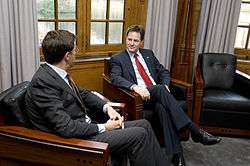


.jpg)
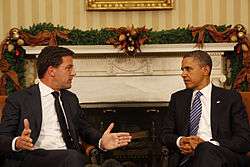
.jpg)
Term
Policy
In accordance with the People's Party for Freedom and Democracy approach to laissez-faire and a small government the number of ministers and State Secretaries was reduced from the previous cabinet by merging several ministries. The Ministry of Agriculture, Nature and Food Quality was merged with the Ministry of Economic Affairs to vorm a combined Ministry Economic Affairs, Agriculture and Innovation. The Ministry of Housing, Spatial Planning and the Environment was merged with the Ministry of Transport and Water Management to form the new Ministry of Infrastructure and the Environment. Also the portfolio of Public security was transferred from the Ministry of the Interior and Kingdom Relations to the Ministry of Justice which was renamed as the Ministry of Security and Justice. Also the position of the Minister for Development Cooperation, a long serving Minister without portfolio title that had been used continuously since 1965 except for a small break from 2002 until 2003 was scrapped and replaced by the return of a Minister without portfolio for Immigration and Asylum Affairs like in the previous Cabinets Balkenende I, II and III, but this time the Minister without portfolio for Immigration and Asylum Affairs was placed in the jurisdiction of the Ministry of the Interior and Kingdom Relations instead of the Ministry of Security and Justice.
Withdrawal of support of the Party for Freedom
Because of the financial crisis in the Netherlands and because of the rules of the Euro convergence criteria that the deficit should be maximum 3%, the Leaders of the People's Party for Freedom and Democracy Mark Rutte, Christian Democratic Appeal Maxime Verhagen and the Party for Freedom Geert Wilders decided to talk with each other about new, severe austerity measures, worth about 14 billion Euro. The negotiations about the measures were held in the Catshuis and lasted 7 weeks and ended on 21 April when Geert Wilders walked out of the negotiations. The reason he gave was that the measure would negatively impact people who receive benefits from the pensions law. Both Mark Rutte and Maxime Verhagen blamed Wilders for the failure of the negotiations. As a result, the government resigned and a new election was called.
Composition Changes
On 16 December 2011 Minister of the Interior and Kingdom Relations Piet Hein Donner (CDA) resigned after he was nominated as the new Vice-President of the Council of State succeeding Herman Tjeenk Willink. He was replaced as Minister of the Interior and Kingdom Relations by former Chairwoman of the Christian Democratic Appeal Liesbeth Spies. Piet Hein Donner as Minister of the Interior and Kingdom Relations was responsible for the portfolio of Integration. When he resigned the Integration portfolio was transferred to Minister without portfolio Gerd Leers.[1][2][3]
Cabinet Members
| Ministers | Title/Ministry | Term of office | Party | |||
|---|---|---|---|---|---|---|
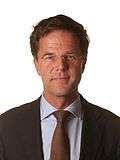 |
Mark Rutte (born 1967) |
Prime Minister | General Affairs | 14 October 2010 – Incumbent |
People's Party for Freedom and Democracy | |
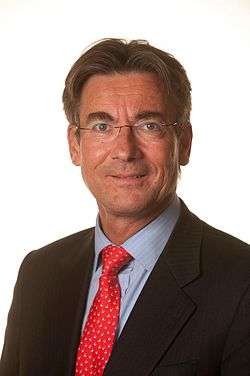 |
Maxime Verhagen (born 1956) |
Deputy Prime Minister / Minister |
Economic Affairs, Agriculture and Innovation |
14 October 2010 – 5 November 2012 |
Christian Democratic Appeal | |
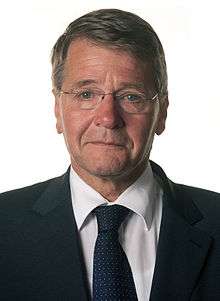 |
Piet Hein Donner (born 1948) |
Minister | Interior and Kingdom Relations |
14 October 2010 – 16 December 2011 [Appt] |
Christian Democratic Appeal | |
 |
Liesbeth Spies (born 1966) |
16 December 2011 – 5 November 2012 |
Christian Democratic Appeal | |||
 |
Dr. Uri Rosenthal (born 1945) |
Minister | Foreign Affairs | 14 October 2010 – 5 November 2012 |
People's Party for Freedom and Democracy | |
 |
Jan Kees de Jager (born 1969) |
Minister | Finance | 23 February 2010 – 5 November 2012 [Retained] |
Christian Democratic Appeal | |
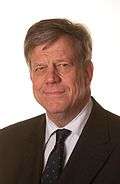 |
Ivo Opstelten (born 1944) |
Minister | Security and Justice |
14 October 2010 – 10 March 2015 |
People's Party for Freedom and Democracy | |
 |
Hans Hillen (born 1947) |
Minister | Defence | 14 October 2010 – 5 November 2012 |
Christian Democratic Appeal | |
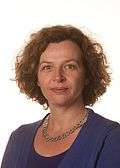 |
Edith Schippers (born 1964) |
Minister | Health, Welfare and Sport |
14 October 2010 – 26 October 2017 |
People's Party for Freedom and Democracy | |
 |
Henk Kamp (born 1952) |
Minister | Social Affairs and Employment |
14 October 2010 – 5 November 2012 |
People's Party for Freedom and Democracy | |
 |
Marja van Bijsterveldt (born 1961) |
Minister | Education, Culture and Science |
14 October 2010 – 5 November 2012 |
Christian Democratic Appeal | |
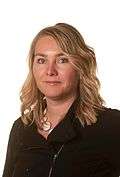 |
Melanie Schultz van Haegen (born 1970) |
Minister | Infrastructure and the Environment |
14 October 2010 – 26 October 2017 |
People's Party for Freedom and Democracy | |
| Minister without portfolio | Title/Portfolio/Ministry | Term of office | Party | |||
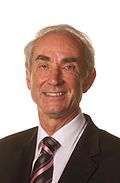 |
Gerd Leers (born 1951) |
Minister | Immigration and Asylum Affairs (within Interior and Kingdom Relations) |
14 October 2010 – 16 December 2011 |
Christian Democratic Appeal | |
| Integration, Immigration and Asylum Affairs (within Interior and Kingdom Relations) |
16 December 2011 – 5 November 2012 | |||||
| State Secretaries | Title/Portfolio/Ministry | Term of office | Party | |||
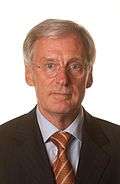 |
Dr. Ben Knapen (born 1951) |
State Secretary [Title] |
• European Affairs • NATO Affairs • Benelux Affairs • Development Cooperation (within Foreign Affairs) |
14 October 2010 – 5 November 2012 |
Christian Democratic Appeal | |
 |
Frans Weekers (born 1967) |
State Secretary | • Fiscal Affairs • Tax and Customs Administration • Local Government Finances • National Mint • State Lottery (within Finance) |
14 October 2010 – 30 January 2014 |
People's Party for Freedom and Democracy | |
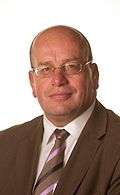 |
Fred Teeven (born 1958) |
State Secretary [Title] |
• Public Prosecution Service • Privacy Policy • Administrative Law • Family Law • Youth Justice • International Law • Prison Administration • Gambling Policy • Copyright Law • Rehabilitation • Prevention • Debt Management • Minority Affairs (within Security and Justice) |
14 October 2010 – 10 March 2015 |
People's Party for Freedom and Democracy | |
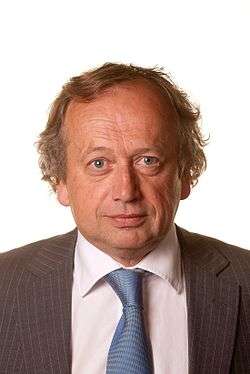 |
Dr. Henk Bleker (born 1953) |
State Secretary [Title] |
• International Trade • Export Promotion • Postal Service • Tourism Affairs • Nature Policy • Agricultural Management • Food Policy • Rural Development • Environmental Remediation • Fisheries • Forestry • Animal Welfare (within Economic Affairs, Agriculture and Innovation) |
14 October 2010 – 5 November 2012 |
Christian Democratic Appeal | |
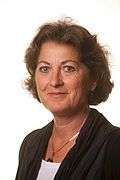 |
Marlies Veldhuijzen van Zanten (born 1953) |
State Secretary | • Youth Policy • Elderly Policy • Disability Affairs • Veteran Affairs • Biotechnology Policy • Medical Ethics Policy (within Health, Welfare and Sport) |
14 October 2010 – 5 November 2012 |
Christian Democratic Appeal | |
 |
Paul de Krom (born 1963) |
State Secretary | • Social Security • Unemployment Affairs • Occupational Safety • Social Services • Poverty Policy • Equality • Emancipation (within Social Affairs and Employment) |
14 October 2010 – 5 November 2012 |
People's Party for Freedom and Democracy | |
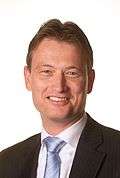 |
Halbe Zijlstra (born 1969) |
State Secretary | • Higher Education • Teacher Policy • Science Policy • Media Affairs • Culture Policy • Arts Policy (within Education, Culture and Science) |
14 October 2010 – 5 November 2012 |
People's Party for Freedom and Democracy | |
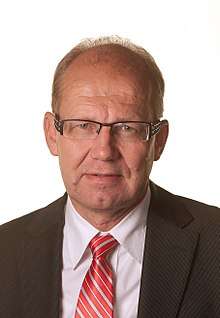 |
Joop Atsma (Born 1956) |
State Secretary | • Aviation Infrastructure • Water Infrastructure • Environmental Policy • Weather Forecasting Service (within Infrastructure and the Environment) |
14 October 2010 – 5 November 2012 |
Christian Democratic Appeal | |
| Source: (in Dutch) Kabinet-Rutte-Verhagen Rijksoverheid | ||||||
- Retained Retained this position from the previous cabinet.
- Appt Appointment: Piet Hein Donner appointed Vice-President of the Council of State.
- Title Allowed to use the title of Minister while on foreign business.
Trivia
- Four cabinet members of the CDA; Maxime Verhagen, Jan Kees de Jager, Piet Hein Donner and Marja van Bijsterveldt served in the previous cabinet, only Jan Kees de Jager continued in the same function.
- The age difference between the oldest cabinet member Ivo Opstelten (66 years, 256 days) and the youngest Melanie Schultz van Haegen (40 years, 108 days) was 26 years, 148 days.
References
- ↑ (in Dutch) Benoeming Spies tot minister vrijdag verwacht, NOS, 15 December 2011
- ↑ (in Dutch) Donner naar Raad van State, NOS, 16 December 2011
- ↑ (in Dutch) 'Spies volgt Donner op in kabinet', NU.nl, 16 December 2011
External links
- Official
- (in Dutch) Kabinet-Rutte I Parlement & Politiek
- (in Dutch) Kabinet-Rutte-Verhagen Rijksoverheid
| Wikimedia Commons has media related to Cabinet Rutte I. |